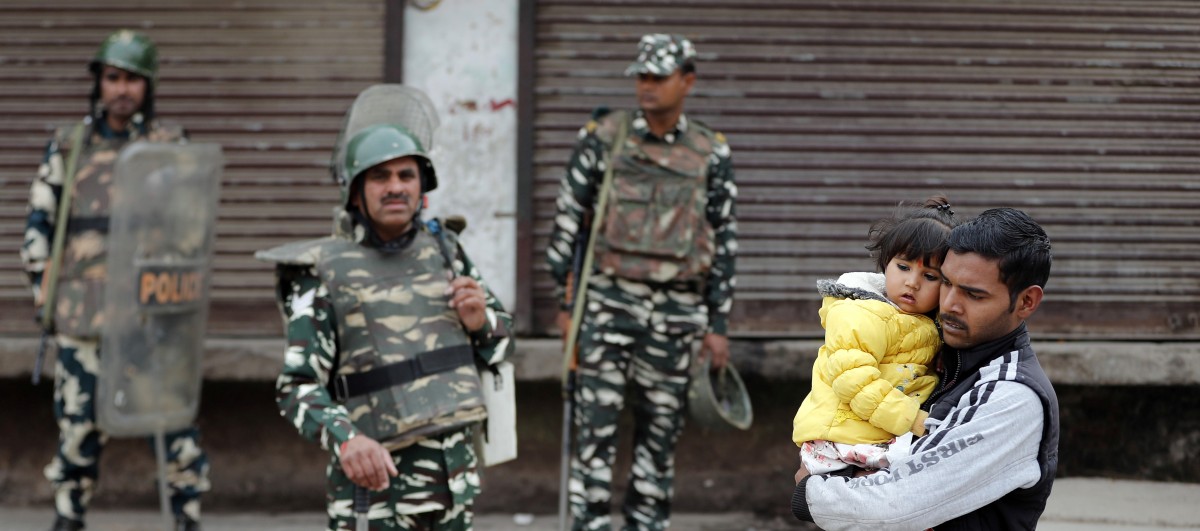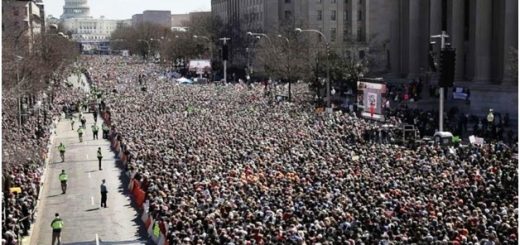Why anti-Muslim stance in many countries? Let’s Call it By its Real Name: Ethnic Cleansing!

Cover image: A man carrying a child walks past security forces in a riot-affected area in New Delhi, February 27, 2020. Photo: Reuters/Adnan Abidi
The Hindutva project of finishing off the minorities has only just begun.

THE WIRE
4 March 2020
Sidharth Bhatia, the writer, is a Mumbai based journalist and author. He has been in the media, print and electronic, for over three decades. Starting in Bombay, he has worked in South Africa, Canada and Mauritius.
In this article he tries to establish that the proper name of Delhi riots is: Ethnic Cleansing. But why? We have always maintained that organized religions have no right to take public space, as we are living today in a secular, democratic world. Secularism and democracy are accepted by all at least in principle, though not practised.
Jihad for Proselytizing?
This has not prevented organized proselytizing religions to make their foray into public space as though it is their right. The worst among them are Islam and Christianity, the first, resorting even to “Jihad”, a violence variously interpreted.
Christians on the whole at least try to assimilate and merge with others in their homes or in their host countries. Pope himself has termed “proselytization a solemn nonsense.”
Muslim League?
Just the opposite is the case with Islam. They isolate themselves and most of them live in ghettos. They are known for their “Ghetto mentality!” Imagine the case even in Kerala of a political party called “Muslim League” branded even by Nehru as a dead horse! Will any other religions join them?
If they can why can’t there be a Christian, Hindu, Sick or Jain Leagues? Even now they insist on their “Madrasa education” from a tender age. They parrot democracy when they migrate to democratic countries, but deny it to those who go to their countries. You are thrown out when you have become a sqaueezed lemon, when you are 60. Why this one way traffic and double standard?
Education is the Key!
Today Europe and the US are protesting against this for long. Even the Pope is criticized for his too friendly association with the Muslim nations. Just two examples have been cited, but there are many more!
Until this mental affinity with all people around the globe as brothers and sisters is achieved, there is little hope of putting an end to Muslim bashing! Please suggest other alternatives to achieve this “Unity in diversity” tom-tommed as the hallmark of India. james kottoor, editor ccv.
Please read below
thought provoking article!
Writing about mass violence is a task fraught with complications. For journalists, especially those who want to report fairly and accurately, using the ‘right’ words to describe the situation is a difficult proposition. Nor can the reporter constantly come up with terminology that meets the requirements of the readers' own bend of mind, to say nothing of ideological point of view. The effort, for the most part, is to write in a way that does not contain too many loaded words.
There has been a lot of social media commentary on why the violence in Delhi should not be termed as a ‘riot’. Riot was the way the colonial power used to describe any outbreak of public violence, one said. A reader pointed out that almost all of it was one-sided and Muslims were specifically targeted, so it should only be termed as “violence perpetrated by Hindu supremacists”. The word ‘pogrom’ has been brought up too.
All these are interesting observations, each one with its own set of problems. At the very least, media reporting deals in shorthand, and riots seems to have become the most-used term, even though the word raises the imagery of two sides fighting pitched battles on the street, while the forces of law and order try and bring about calm.
That, as we know, has not been the case in Delhi. Any reasonably experienced cop will tell you that if the police wants to, it can stop such violence within hours, The cops in this case – and in many other cases in India in the past – have not just been idle observers, but have participated with gusto in joining the perpetrators of violence against hapless, innocent victims. For the moment, ‘riots’, though not ideal, should do, as much as for its brevity as in conveying an abnormal, violence, conflict in which ordinary citizens have been affected.
But it is important to look beyond just media reportage and consider what the violence in Delhi is all about. There have been such instances before, when armed men have set upon members of a minority community in an organised manner – 1984, 1992-93 and 2002 are seared into the minds of all Indians. In all the instances, even when there was retaliation – as was seen in 1992-93 in Bombay – in the end, it was the minority communities that suffered the most, in terms of lives lost, homes destroyed and businesses burnt down.
The violence in Delhi follows that pattern – the idea is to not just kill and maim, but also go after their places of worship and, more significantly, their places of work, thus destroying them economically. All this is done with clinical precision – often, the mobs carry lists of Muslim homes and shops.
Yet, the Delhi violence is very different too. It has to be seen in the context of all that has happened in the last six years, and especially of the past year. It is part of a bigger effort to once and for all ‘solve the Muslim problem’, which, for the Sangh parivar and the assorted forces of Hindutva and their numerous supporters, is a long-cherished fantasy.
For almost a century, the minds of RSS leaders have focused on how to subjugate Muslims in a way that they become second class citizens – non-people, as it were – because much as they would like, it is difficult to get fully rid of them physically. Over the past 70 years, the Sangh remained an outsider, but when it got a chance, as in Gujarat, it set about finishing them off as much as possible. Today, to be a Muslim in that state is to experience daily humiliation and be constantly reminded that they count for nothing.
The big opportunity came in 2014, when Narendra Modi, under whose rule the anti-Muslim violence happened with impunity, became the prime minister. The first term saw no acts of mass killing, but countless scattered incidents of lynchings and other anti-Muslim violence and a visible rise in communally charged statements by BJP leaders. It created an environment where saying the most outrageous things about the minorities became normal; even Modi shed his prime ministerial robe during election campaigns. Anti-Muslim prejudice was always no more than skin deep, so this sustained campaign against them found a fertile ground to grow in.

Security forces patrol in a riot affected area in New Delhi, February 27, 2020. Photo: Reuters/Rupak De Chowdhuri
That Modi came back with a thumping majority in 2019 clearly meant that his supporters did not see such communalism as a problem, but probably an endorsement of the Hindutva project. And the party and its leaders have not disappointed.
From the National Register of Citizens process in Assam, which was designed to weed out Muslims, but went off-script when Hindus were listed in substantial numbers, to the locking down of eight million people in Kashmir, throwing all constitutional provisions to the winds to now the violence in Delhi – all have been aimed at marginalising Muslims. Educational institutions identified with Muslims, such as Jamia Millia Islamia and Aligarh Muslim University, have been targeted and plans have been made to roll out the Citizenship (Amendment) Act-NRC process all over the country. The protests may have slowed down the schedule, but is there any doubt left what the ultimate goal of this regime is?
The sequencing – or chronology, to use a very familiar term – matters. The violence in Delhi is not a spontaneous outburst because of some local issue that got out of hand. During the campaign for the Delhi elections, minister Anurag Thakur roused the crowds with slogans of ‘shoot the traitors’, aimed squarely at the peaceful protestors at Shaheen Bagh. Immediately after the elections, Kapil Mishra (who was once with the Aam Aadmi Party) gave an ultimatum to the Delhi police to remove the protestors. The violence started immediately after that, and neither Thakur nor Mishra has been held accountable.
The prime minister maintains a stoic silence, Amit Shah is trying to sound like his combative best and the police allows violence against Muslims to continue. Meanwhile, His Lordships show no urgency in stepping in, declaring the courts cannot be expected to stop violence from occurring and the sarkari media finds different ways to convey the brutality of Muslims against Hindus.
All this – creating an atmosphere against Muslims, using all legislative devices to take away their citizenship, locking up millions of them by stripping them of their rights and land and now, unleashing planned violence against the most vulnerable sections of the community – can only mean a bigger plan of ethnic cleansing.
Classical forms of ethnic cleansing may involve waves of physical violence, such as in Rwanda or Bosnia which end up in the deaths of tens of thousands. The global community could not stop those, but it has since learnt its lessons. President Donald Trump may have been neutral, but many countries, including friends like Iran, have expressed deep alarm. The intervention in India’s courts by the United Nations Human Rights Commissioner is a first for this country.
What we are seeing is the Indian version of ethnic cleansing. In a country as large as India, and with entrenched democratic institutions and a fairly robust federal structure, to say nothing of diversity, ‘getting rid’ of 200 million Muslims won’t be an easy task. But that is not going to stop the Sangh from trying. It controls parliament and it runs the government and exercises influence with other institutions too. And it has real state power in many states.
Most of all, it has patience. The media functions as the propaganda arm. The virus is spreading, fast – one day perhaps the people will rise to the Sangh’s job for it. The violence in Delhi will slow down and stop soon – but the Hindutva project of finishing off the minorities has only just begun.


















Shri Sidharth Bhatia has reported that the United Nations Human Rights Commissioner has approached the Supreme Court of India against the Citizenship Amendment Act 2019. But the fact is it is the United Nations High Commissioner for Refugees, Michelle Bachelet Jeria, who has moved the Supreme Court seeking to have a say on the Citizenship Amendment Act (CAA), which she claimed lacked objectivity and rational and detracted from India’s international obligations not to discriminate between migrants on the basis of religion or render anyone stateless. The Centre reacted by saying the Act was an internal matter and concerned the sovereign right of Parliament to make laws. “We strongly believe that no foreign party has any locus standi on issues pertaining to India’s sovereignty,” official spokesperson of the Ministry of External Affairs, Raveesh Kumar, said.
However, it would be of interest to watch the reaction of the Supreme Court of India in the light of human rights treaties signed by India with the United Nations. Will the Supreme Court see any conflict of interest on India's part?